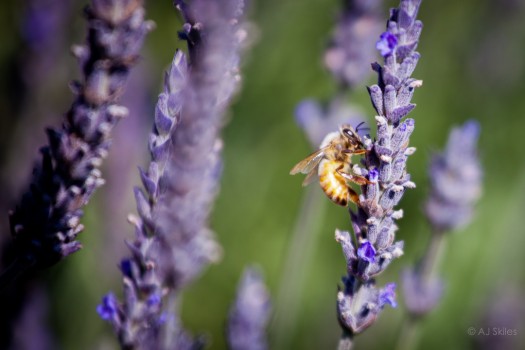If you a bought a fancy new oven, you wouldn’t expect to instantly become a great chef. Unsurprisingly, photography is the same. You gotta learn how to cook first.
Despite what Canon or Apple would like you to think, just because you have a fancy camera – whether it be your iPhone or a DSLR – doesn’t mean you automatically start taking great photos. Knowing the simple principles of photography is the key to creating great photography. The following are 5 Tips to Improve Your Photography. Let’s get cooking.
Do: On the iPhone, you can tap on the image to change the focus & exposure point.
The Rule of Thirds
Unless you’re Wes Anderson or shooting a target, try not to compose your shots right in the middle of the frame. Rather, compose your shots using the The Rule of Thirds.
The first step is turning on the grid lines feature on your phone or camera. This feature will superimpose a grid breaking up your image into nine equal parts by placing two equally spaced horizontal lines and two vertical lines. Composing your shots where these lines intersect will create more tension, energy, and interest to your photos.

The Rule of Thirds in action: The sky takes up two-thirds while the city takes up the remaining one-third.
Do: Stabilize your camera by using a tripod or a case with built-in stand.
Composition
This next tip is really three in one: using pattern and repetition, framing, and/or leading lines. Before you take your shot, look around you. Are there elements in the scene that can add visual interest to your photo? Where do you see lines?

Look for repeated elements like these arches found in the Santa Barbara Courthouse.
Do: Are there any distracting elements? Dealing with them before your shot is much easier than dealing with it after.
Repetition and patterns are visual elements that naturally draws the eye, the human brain just loves them. Lines or patterns of trees, people, or just about anything can add interest and excitement to your photography. Also look out for framing devices like doorways, arches, or anything else that be used to creatively frame your subject.

Tunnels make great frames to shoot through, just make sure you are framing something interesting (unlike this boring photo, but hey, it’s still framing).
Keep your eye out for leading lines, which are any lines in a photo that leads your eye to another point in the image or even out of the image. Hand rails, walkways, and hedges are just three in an infinite list of possible leading lines. Add leading lines with The Rule of Thirds for maxim effect. Also, changing up your angle or viewpoint in your shot can help you find leading lines.
Don’t Do: Avoid using the digital zoom – use your feet and move closer, if you can.
Mix Up your Angles
We all view the world at eye-level – changing up the level you shot at can add more emotion and drama to your shots. Try a low-angle shot to add more power to your subject. A high angle or bird’s eye view can can drama and importance to your shot, as well. Try shooting from the ground up by either laying down, using a short tripod, or even just bending to one knee, all are great ways to add a little bit more umph to your capture.

The low angle in this shot helps add more importance and weight to this famous statue of King Sejong, creator of the modern Korean alphabet, found in Seoul, South Korea.
Do: Straighten your horizon! The ocean doesn’t dip left or right nor should your photo of the ocean.
Looking down on your subject can cause the subject to look weak and timid or friendly and approachable. If you’re shooting children or animals, remember to shoot from their eye-level or lower. How do they view the world?
Lighting
Photography comes from the two Greek words: phōtos and graphé, together they mean “drawing with light”. So it should come as no surprise that photography is all about the light.

While the subject and composition may be interesting, poor lighting can prevent your photo from being great.
If your lighting is flat, your photo is going to be flat. Sometimes flat lighting can be good, but knowing the difference in the quality of light is how greatness is achieved. Pay attention to your light source. If your light source is the sun, keep in mind that direct sun overhead is not ideal. The best light in usually in the early morning, late afternoon, and best of all is the golden or magic hour. If you can’t wait for better lighting, try shooting in open shade, like the shade of a large tree.
Also be prepared to grab your camera before, during, and after a storm or any extreme weather for camera-ready clouds. Obviously be careful out there, no need to win a Darwin Award over a photo.
Don’t Do: Avoid standing in just one spot only. The perfect shot could be just a couple of feet to the right.

An inexpensive reflector was used to bounce light back onto these delicious burgers.
Have one of those car shade things in your car? Then you already own a great photography tool, the reflector. You can use the shiny side to bounce a little light onto your subject. Sometimes that little bit of light the reflector provides is just enough to save your otherwise boring shot. Reflectors are so useful and inexpensive I carry around a mini-reflector in my backpack all the time.
Shutter Speed
Change up your shutter speed to capture more or less time in your shot. Using a faster shutter speed can help you capture a shot the instant a ballon pops. Or you may want to slow down your shutter speed to blur passing lights of cars or smooth out the flow of water. All these things require you to manipulate your shutter speed, something that can even be done on your iPhone with the right app.
Do: Use a tripod to stabilize your shots. They even make inexpensive tiny ones for iPhones and other mobile devices.
Remember, there are no real “rules” to photography. These are just a handful of tips and guidelines that usually improve most images. But by knowing the “rules” you can better judge when to use them and when break them. And the most important take-away is practice and experiment – that’s really the only sure way to make your photography great.











